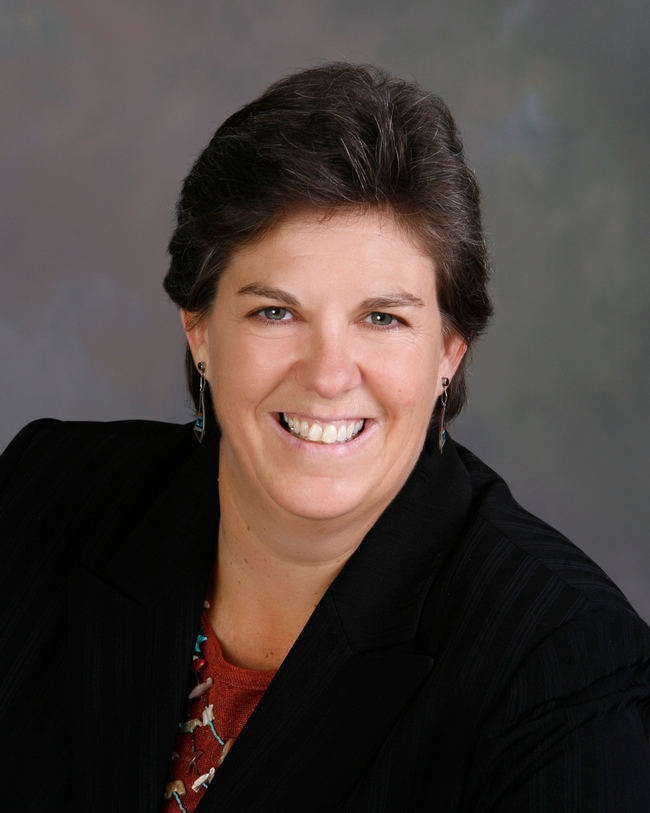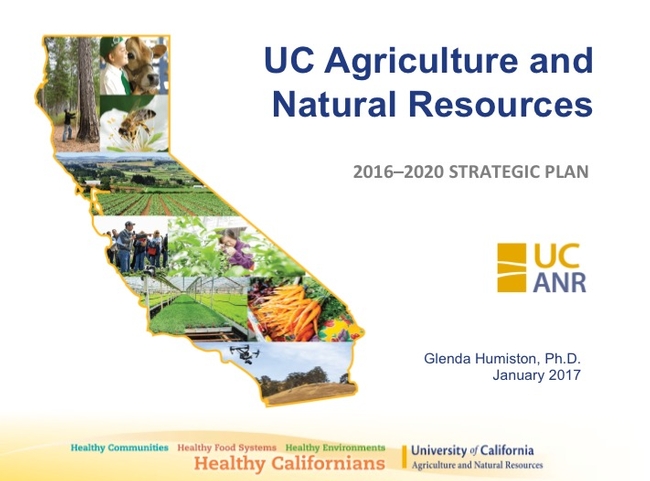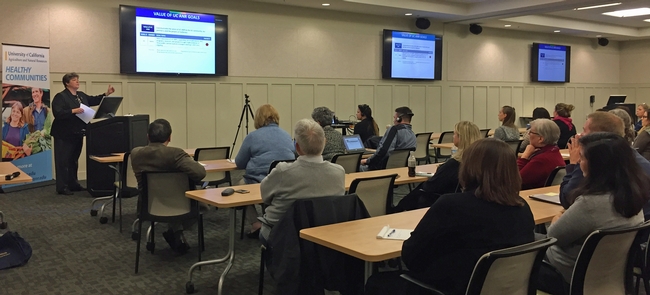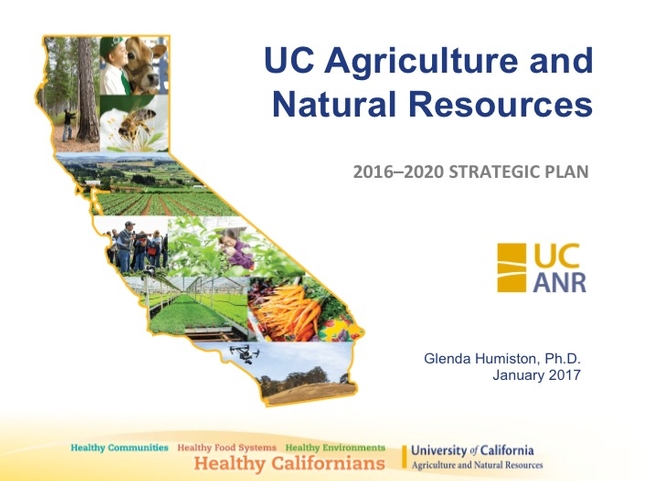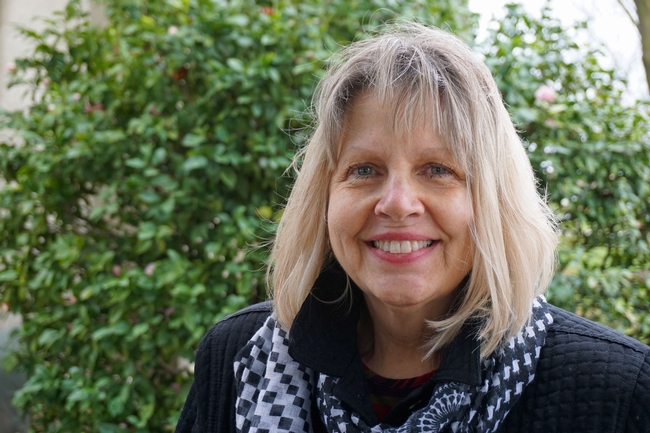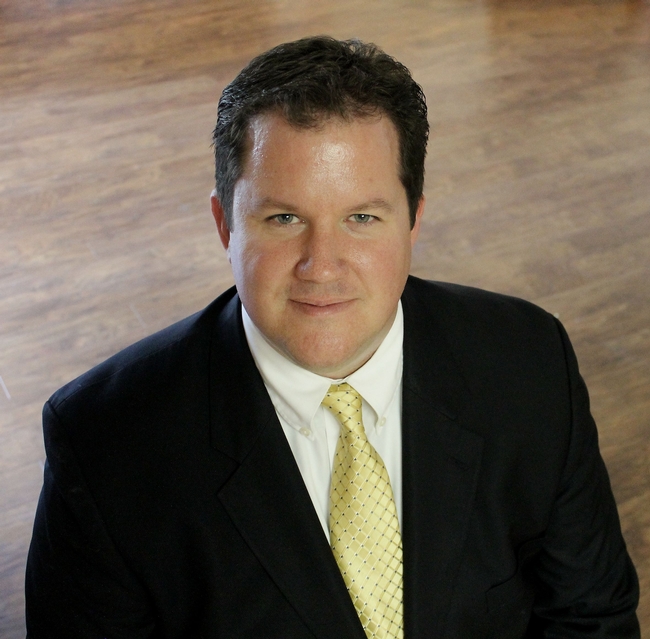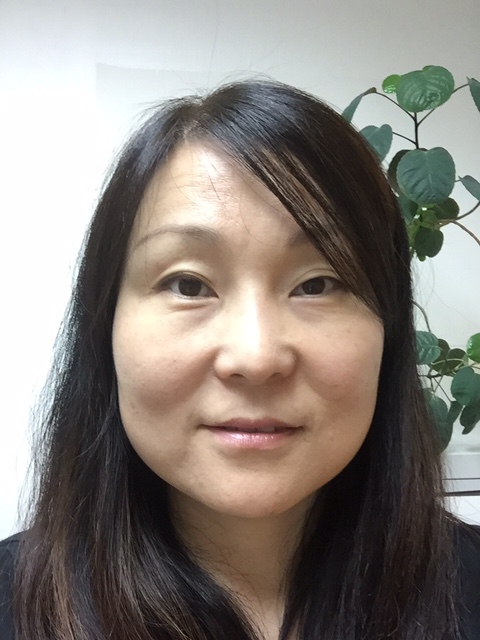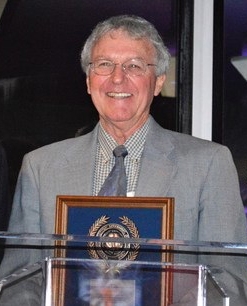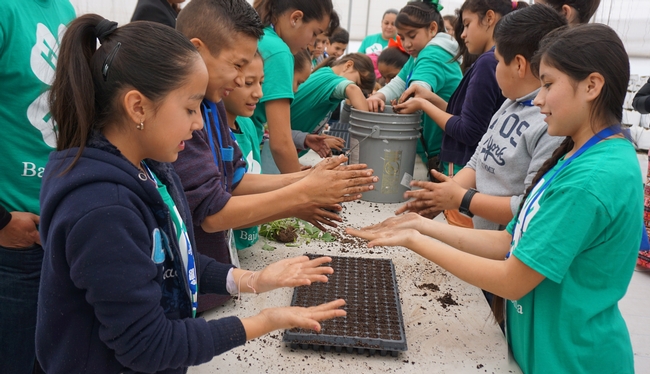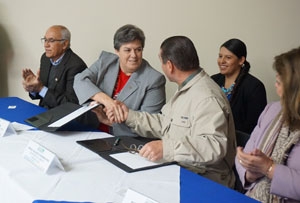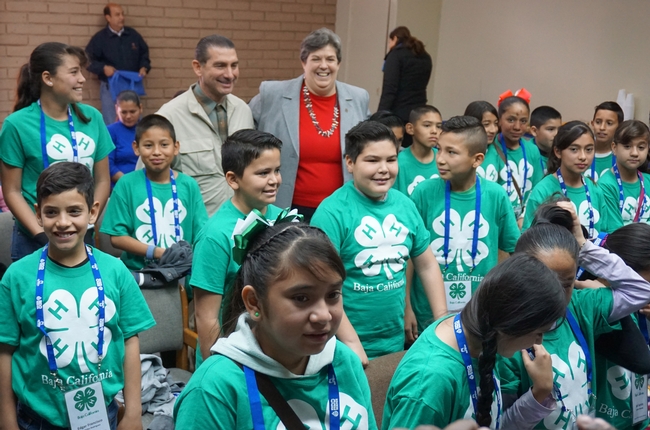Posts Tagged: Lori Berger
ANR embarks on development of action plans for five-year Strategic Plan
Dear Colleagues,
In August 2016, President Napolitano requested a five-year strategic plan for UC ANR by December 2016. To meet that ambitious deadline, the Senior Leadership Team worked closely with the strategic planning resources at UCOP and UC ANR to guide us through a rigorous process. We enlisted the assistance of representatives of programs and administrative units and drew upon strategic plans that already existed within the statewide programs, strategic initiatives, research and extension centers and budget plans. We also consulted UC ANR advisory groups and committees. When I presented our draft plan to President Napolitano in November, she was clearly pleased with its goals and key strategies for achieving them. The final plan was submitted to the President in late December.
I am now very excited to share the strategic plan with you; it is available at http://ucanr.edu/stratplan1.10.2017. This plan will guide us in a thoughtful and timely manner as we “operationalize” our Strategic Vision 2025. As you read through the strategic plan, please think about how your work aligns with the goals in the plan. I consider this to be a living document that we will modify, add to, and improve upon over time, so your feedback is not only welcome, it's vital.
The five-year plan calls for an estimated $54 million in one-time new costs, including approximately $40 million for capital investments in UC ANR facilities and system infrastructure. To fund the one-time costs, we will finance debt, expand our fundraising capacity and deploy some of our reserves. Ongoing annual costs for the five-year plan are estimated at $6.5 million and will be funded from projected revenue increases of $12 million, which will leave us an estimated annual net operating increase of $5.5 million.
The plan defines 15 goals to enhance UC ANR's research and extension mission, support employees and volunteers, address financial stability and administrative excellence, and increase awareness of UC ANR's value. As you can see on page 30 of the attached plan, each goal has been assigned an “owner,” who will be responsible for overseeing our progress toward its attainment. Our next step is to develop specific action plans with point people, metrics and target dates to reach our goals.
To move the strategic plan from paper to action, I have invited 22 people representing campuses, counties, research and extension centers, administrative units and more to meet at the end of this month. At the two-day meeting, we will begin developing action plans to achieve the 15 goals in the strategic plan. We will also explore how best to engage all UC ANR members in this process because everyone's contribution is critical to the UC ANR mission.
As we map out the paths to our goals, we will be soliciting feedback and engaging different people within UC ANR and external stakeholders. We will keep you apprised of our progress via ANR Update, social media, our website and other reporting. In addition to those regular communications venues, Wendy Powers, associate vice president, will provide informal updates through a new blog she recently launched at http://ucanr.edu/ANRAdventures.
You can offer feedback and collaboration via our many workgroups, advisory committees and public forums, or by sending a comment here.
By identifying and taking specific steps that lead to our goals, we will successfully achieve our Strategic Vision. If you have comments or suggestions for this process, I would love to hear from you. Please submit them to me using this link http://ucanr.edu/5yearplancomments.
Best regards,
Glenda Humiston
Vice President
Strategic plan takes center stage
Editor's note: This is an excerpt from AVP Wendy Power's new blog “ANR Adventures.” For news about the recruitment process for the Vice Provost – Statewide Programs and Strategic Initiatives and Vice Provost – Cooperative Extension positions, read her blog at //ucanr.edu/blogs/Adventures.
Wednesday (Jan. 18) was the Town Hall meeting to provide an overview of the UC ANR strategic plan and answer any questions. At one point, 177 participants joined the conversation via Zoom and approximately 50 of us were in the UC ANR building in Davis.
VP Glenda Humiston provided overviews of the goal of the strategic plan, the process used to gather input and the resulting goals in the plan. The remaining 45 minutes or so of the hour-long meeting was focused on questions.
Several questions were related to fundraising (plans and strategies to raise funds, intended uses of the funds). Other questions were around communicating progress on reaching the goals set forth in the plan. This is a great question and one that one of the strategic initiative leaders got me thinking about late last week. Somehow we want to be able to share the division's progress on attaining the goals without getting bogged down with details about where we are in the process. Any suggestions? If you have some, I'd love to hear them! One of the Zoom participants suggested a graphic or visual representation – maybe something like the thermometers that organizations use to show status of fundraising targets? Give this some thought and I will give it some more thought, too.
One of the questions was about the program prioritization process (Goal #5). Like pretty much all of the goals, we don't know what the result of this will look like and haven't formulated a plan to go about gathering information and making any decisions needed to reach this goal. This will be a portion of the agenda for a two-day retreat to take place at the end of the month. As the “goal owner” for Goal #5, I have to admit that I was perfectly comfortable early on in the strategic plan development process to leave this as a strategy under another goal. But I understand and “buy in” now to the idea that this is so important to who we are and the value we bring to California that it makes sense to have this as a stand-alone goal. As I said at the town hall, it is a good business practice to review what you do and how you do it. But this is no easy task for such a large organization with so many different programmatic efforts, all of which make a difference in someone's life. And key questions to think about as we undertake the process are what, if any, programming is needed to realize the 2025 Vision and how do those needs align with current efforts? Still a huge task and, as a result, a few of us have met with someone who I think can help all of us work toward answers.
Following development of a draft plan at the retreat, I intend to share the plan with strategic initiative leaders, statewide program and institute directors and county directors, then finalize a process and approach for having these big conversations so that they are inclusive, not overly time-consuming and lead to information that furthers us in our goals. No doubt success will take time and will benefit from the collective brainpower of everyone at UC ANR. I suspect it's one of those things that you get out of it, what you put into it.
Names in the News
Berger named IPM academic coordinator
Lori Berger has been promoted to academic coordinator for the Pests, Pesticides and IPM Project, effective Oct. 15. Berger joined ANR in 2014 as a project coordinator for the UC ANR Statewide IPM Program. In this role, she coordinated a project to identify and manage critical uses of chlorpyrifos in almonds, citrus, cotton and alfalfa. The work included analysis of research and policy gaps for IPM, crop protection chemicals and alternative technologies pending regulatory concerns and anticipated regulations. She also developed and managed a statewide outreach program for new web-based decision support tools.
Before joining UC ANR, Berger was the founding executive director of the grower-supported California Specialty Crops Council, leading technical and regulatory affairs for a diverse array of fresh and processed fruit, vegetable, berry and vine crops from 2000 to 2013. She has also worked for two Fortune 500 companies in R&D and technical services for new product and market development.
Throughout her career, Berger has worked extensively with the regulatory community in developing science-based approaches to pest management and agricultural production. She has been an appointed member on several USDA and EPA federal advisory committees, including the Pesticide Program Dialogue Committee (PPDC), Committee to Advise on Reassessment and Transition (CARAT), and the Farm, Ranch and Rural Communities Committee (FRRCC). In these roles, she has shared her expertise on pest management, pollinator protection, international MRLs, water quality and soil health.
Berger holds a Ph.D. in entomology from Texas A&M University, an M.S. in entomology from Oklahoma State University and a B.S. in crop science from the University of Wyoming. She also earned an MBA from the Sid Craig School of Business at California State University at Fresno. A graduate of the California Agricultural Leadership Program, Berger is a licensed pest control adviser and certified crop adviser.
Berger is based at the Kearney Agricultural Research and Education Center in Parlier and can be reached at (559) 646-6523 and lberger@ucanr.edu.
Youtsey appointed Chief Innovation Officer
As of Jan. 12, Gabe Youtsey, chief information officer, has been appointed to serve as UC ANR's Chief Innovation Officer during 2017 to work directly with VP Glenda Humiston in support of one of the division's key objectives, Innovation & Entrepreneurship, as outlined in our strategic plan.
In accepting this assignment, Youtsey will be a key catalyst in the Innovation and Entrepreneurship initiative, working both within UC and with external industry, government and academic institutions to partner in creating ANR's innovation and entrepreneurship program.
The program is aimed at facilitating ANR impacts in agriculture and natural resources through a new statewide support system that will allow new technologies to be explored, adopted and ramped up faster. Another facet of the program is to create a pipeline of new entrepreneurs for the booming field of agricultural technology.
“New groups of people – from high school students to Silicon Valley professionals – are showing lots of interest in where their food comes from, and in solving pressing problems to preserve California for generations to come,” Youtsey said. “ANR's Innovation and Entrepreneurship program is meant to build a statewide bridge that spans industries and allows UC ‘ag tech' entrepreneurs to thrive, and brings in the new talent and energy of students and professionals in other industries.”
He will continue to participate on the Senior Leadership Team and the Vice President's Council and will continue to advise the vice president and Tu Tran, associate vice president for UC ANR Business Operations, on information technology and cyber risk issues as the Cyber Risk Executive for the division.
In this new role, Youtsey will turn responsibility for management and operations of the Information Technology unit over to Dave Krause, web and application development manager, and Tolgay Kizilelma, infrastructure and support manager. Krause and Kizilelma will report directly to Tran during this period.
Yu named Financial Services director
After an open search, Jing Yu has been named ANR's director of Financial Services.
Yu, who has served in the interim director's role for the past year, assumes leadership of a function that has increasing strategic importance in the years ahead, at ANR and UC systemwide, with a focus on modernizing financial and business systems in addition to a focus toward balance sheet financial management to best support future capital needs and debt financing, said Jake McGuire, controller.
Yu joined ANRFinancial Services in 2013 from the UC Berkeley Controller's Office, where she started her career with UC in 2009. She is a California certified public accountant (CPA), has a master's degree in accounting and finance, and over 15 years of business, finance and accounting experience in the institutional, corporate and public accounting firm sectors.
Yu is based on the 10th floor at UC Office of the President in Oakland and can be reached at (510) 987-0059 and Jing.Yu@ucop.edu.
Hutmacher named Cotton Specialist of the Year
Robert Hutmacher, UC Cooperative Extension cotton specialist and West Side Research and Extension Center director, was named the 2017 Cotton Specialist of the Year at the Beltwide Cotton Conference in Dallas, Texas.
“Dr. Robert Hutmacher is a master of defining a grower challenge, rallying all parties to come to the table to address the challenge and then working with growers to put that science to work in their fields,” said Kenny Melton, Bayer western regional agronomic manager. “Whether the challenge is finding resistance to Fusarium wilt Race 4 or increasing water efficiency, Dr. Hutmacher rises to the challenge. It's an honor to work with him and a special joy to help bestow this award.”
The 2016 recipient, Gaylon Morgan, Texas A&M AgriLife Extension Service cotton specialist, presented the 2017 award to Hutmacher.
“Bob is a highly respected leader who California growers depend on to navigate the ups and downs of the cotton industry in their state,” said Morgan. “He has helped growers find the path to profitability. That kind of leadership is essential not only in California, but also nationally. He has earned this honor many times over.”
California 4-H helps launch hands-on learning club for children in Mexico
Over the last 100 years, the UC ANR 4-H Youth Development Program has taught California children about food, agriculture, leadership and community service using learn-by-doing practices. To offer 4-H expertise to children south of the border, Vice President Glenda Humiston traveled to Mexicali to sign a memorandum of understanding with Baja California Secretary of Agriculture Manuel Vallodolid Seamanduras on Jan. 20.
“The need for education doesn't stop at the border,” said Lupita Fábregas, assistant director for 4-H diversity and expansion and UC Cooperative Extension 4-H advisor. “The wonderful educational opportunities available to California youth are now being offered to a group of children in Mexicali. And that program will be a model for the rest of Baja California and Mexico.”
Addressing the children gathered at the signing ceremony, Humiston said, “We're excited to share the 4-H experience with you.”
Today, projects in new technologies – like drones and rocketry – join more traditional projects – like cooking, sewing, animal husbandry and farming – to give youths channels to explore a wide variety of options and interests.
“We are looking into expanding to community colleges and offering education for future entrepreneurs or youth interested in skilled trades,” said Humiston, who credits 4-H with enabling her to be the first in her family to attend college.
The establishment of a club like 4-H in Mexico is the fulfillment of a life's dream for Claudia Diaz Carrasco, 4-H youth development advisor in Riverside and San Bernardino counties.
“I found my passion,” said the native of Mexico City. “To solve world hunger, we need to find solutions one community at a time. 4-H does that.”
Newer ANR academics invited to Programmatic Orientation Feb. 22-24
Recently hired academics are invited to join ANR leadership for the third Programmatic Orientation, Feb. 22-24, to discuss the mission of UC ANR and our varied roles in California and the university.
The orientation will be held at Kearney Agricultural Research & Extension Center in Parlier. On the second day, participants will tour successful research and outreach programs in the area.
Take this opportunity to engage in discussions with colleagues about the resources and opportunities available through ANR as a division.
All UC Cooperative Extension advisors and specialists, academic coordinators, academic administrators and Agricultural Experiment Station faculty who have been hired in recent years and have not attended past ANR's Programmatic Orientation in the past are welcome.
A draft agenda for this year's programmatic orientation is available and will be updated with tour details at http://ucanr.edu/sites/orientations/Programmatic_Orientation_819/Agenda_840. Lodging is available for participants, see http://ucanr.edu/sites/orientations/Programmatic_Orientation_819/Location_and_Lodging.
Register at http://ucanr.edu/sites/orientations/Programmatic_Orientation_819/Registration.
For more information, contact UC ANR Program Support Unit at (530) 750-1256 or (530) 750-1260.

